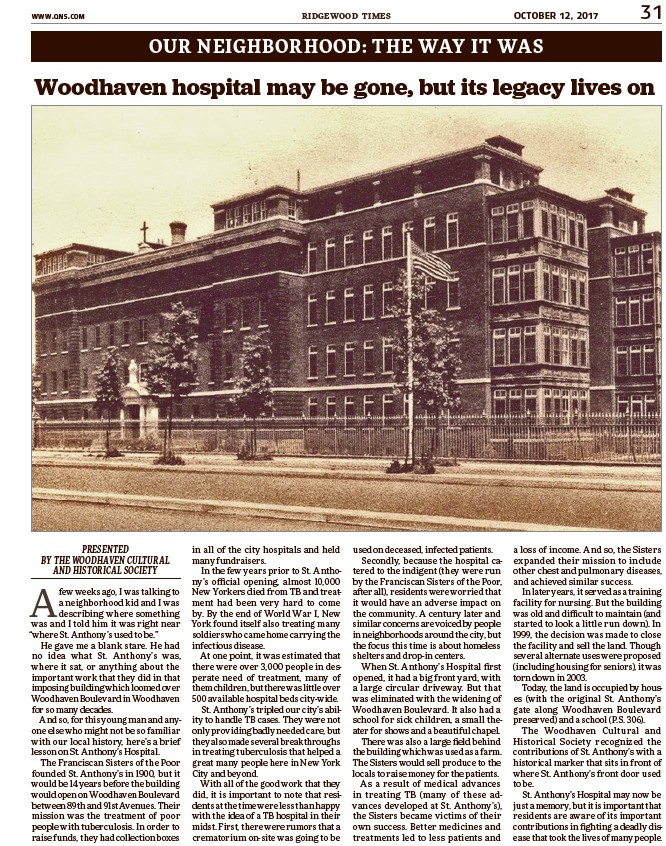
WWW.QNS.COM RIDGEWOOD TIMES OCTOBER 12, 2017 31
OUR NEIGHBORHHEOAODDI:N TGHE WAY IT WAS
Woodhaven hospital may be gone, but its legacy lives on
PRESENTED
BY THE WOODHAVEN CULTURAL
AND HISTORICAL SOCIETY
A few weeks ago, I was talking to
a neighborhood kid and I was
describing where something
was and I told him it was right near
“where St. Anthony’s used to be.”
He gave me a blank stare. He had
no idea what St. Anthony’s was,
where it sat, or anything about the
important work that they did in that
imposing building which loomed over
Woodhaven Boulevard in Woodhaven
for so many decades.
And so, for this young man and anyone
else who might not be so familiar
with our local history, here’s a brief
lesson on St. Anthony’s Hospital.
The Franciscan Sisters of the Poor
founded St. Anthony’s in 1900, but it
would be 14 years before the building
would open on Woodhaven Boulevard
between 89th and 91st Avenues. Their
mission was the treatment of poor
people with tuberculosis. In order to
raise funds, they had collection boxes
in all of the city hospitals and held
many fundraisers.
In the few years prior to St. Anthony’s
offi cial opening, almost 10,000
New Yorkers died from TB and treatment
had been very hard to come
by. By the end of World War I, New
York found itself also treating many
soldiers who came home carrying the
infectious disease.
At one point, it was estimated that
there were over 3,000 people in desperate
need of treatment, many of
them children, but there was little over
500 available hospital beds city-wide.
St. Anthony’s tripled our city’s ability
to handle TB cases. They were not
only providing badly needed care, but
they also made several breakthroughs
in treating tuberculosis that helped a
great many people here in New York
City and beyond.
With all of the good work that they
did, it is important to note that residents
at the time were less than happy
with the idea of a TB hospital in their
midst. First, there were rumors that a
crematorium on-site was going to be
used on deceased, infected patients.
Secondly, because the hospital catered
to the indigent (they were run
by the Franciscan Sisters of the Poor,
aft er all), residents were worried that
it would have an adverse impact on
the community. A century later and
similar concerns are voiced by people
in neighborhoods around the city, but
the focus this time is about homeless
shelters and drop-in centers.
When St. Anthony’s Hospital fi rst
opened, it had a big front yard, with
a large circular driveway. But that
was eliminated with the widening of
Woodhaven Boulevard. It also had a
school for sick children, a small theater
for shows and a beautiful chapel.
There was also a large fi eld behind
the building which was used as a farm.
The Sisters would sell produce to the
locals to raise money for the patients.
As a result of medical advances
in treating TB (many of these advances
developed at St. Anthony’s),
the Sisters became victims of their
own success. Better medicines and
treatments led to less patients and
a loss of income. And so, the Sisters
expanded their mission to include
other chest and pulmonary diseases,
and achieved similar success.
In later years, it served as a training
facility for nursing. But the building
was old and diffi cult to maintain (and
started to look a little run down). In
1999, the decision was made to close
the facility and sell the land. Though
several alternate uses were proposed
(including housing for seniors), it was
torn down in 2003.
Today, the land is occupied by houses
(with the original St. Anthony’s
gate along Woodhaven Boulevard
preserved) and a school (P.S. 306).
The Woodhaven Cultural and
Historical Society recognized the
contributions of St. Anthony’s with a
historical marker that sits in front of
where St. Anthony’s front door used
to be.
St. Anthony’s Hospital may now be
just a memory, but it is important that
residents are aware of its important
contributions in fi ghting a deadly disease
that took the lives of many people.